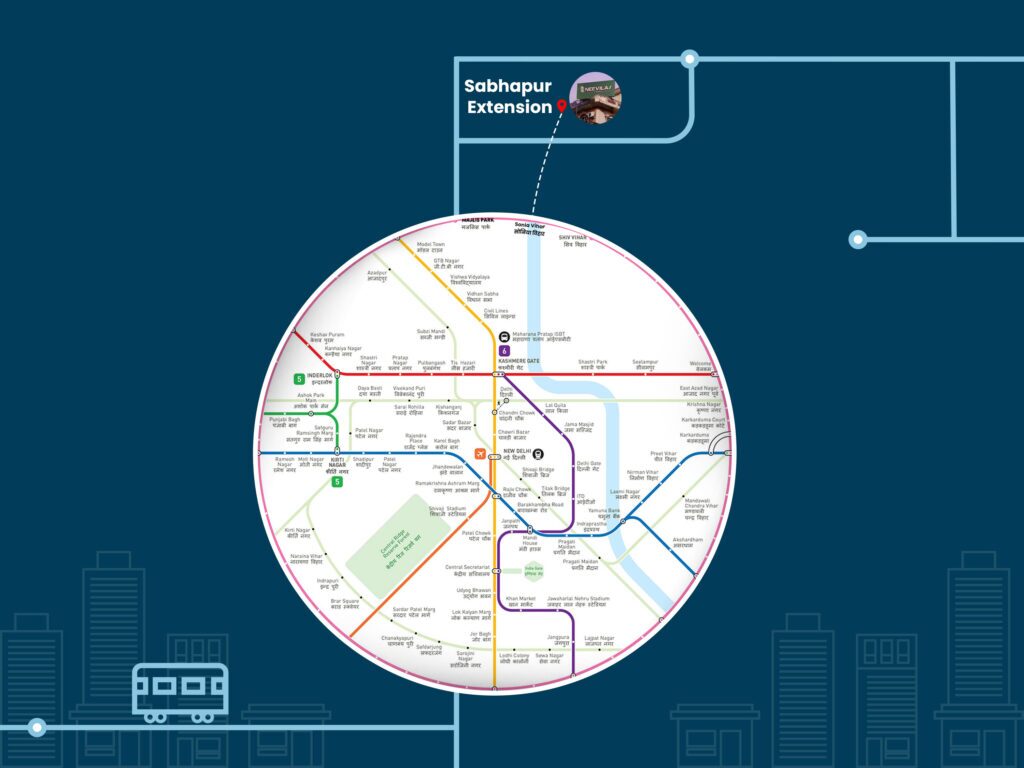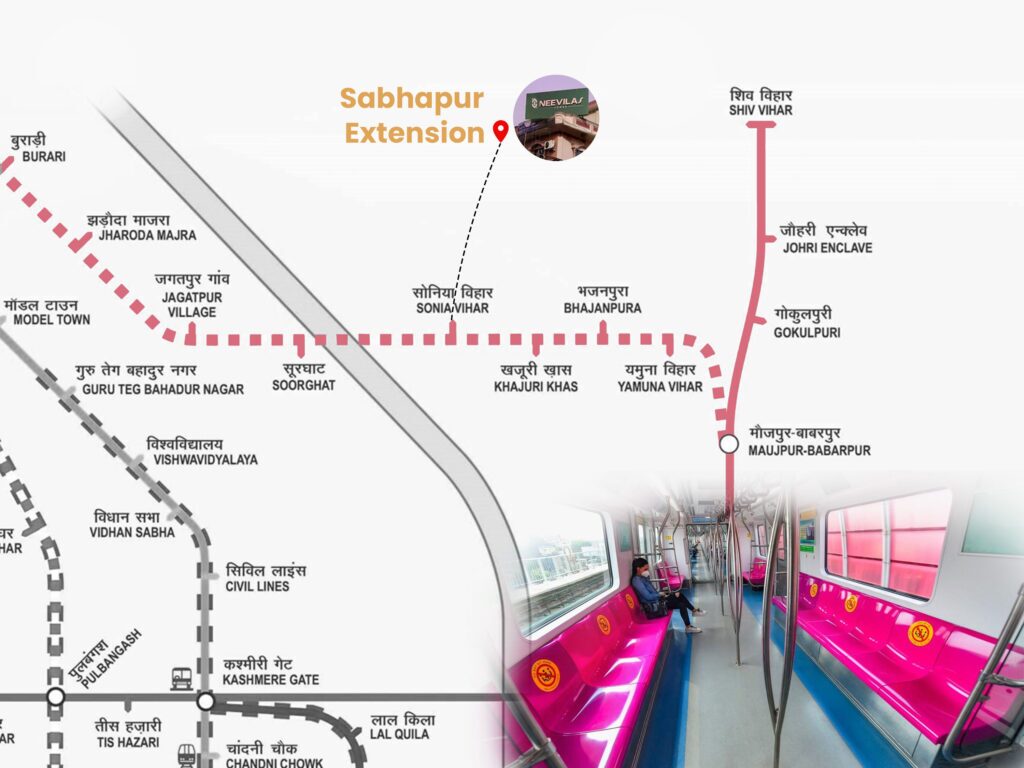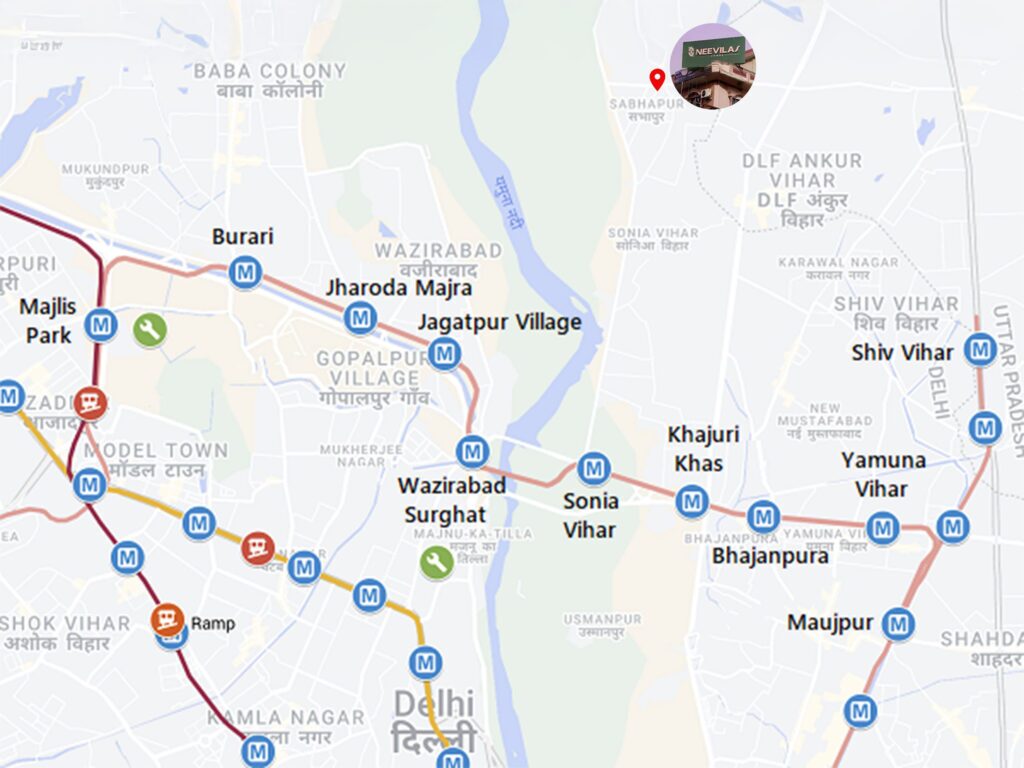
The Pink Line (officially Line 7) of the Delhi Metro is a pivotal component of India’s most extensive urban rapid transit system, designed to transform intra-city mobility in the National Capital Region (NCR). Spanning 59.24 km with 38 stations (26 elevated and 12 underground), it is currently the longest metro line in India, forming a near-circular “U-shaped” corridor that encircles much of Delhi’s outer ring. Inspired by the historic Delhi Circular Railway, the Pink Line’s core essence lies in its orbital connectivity: it bridges North, West, South, and East Delhi, alleviating congestion on the arterial Ring Road, reducing cross-quadrant travel times by up to 50%, and integrating key commercial, residential, and transport hubs.
This line serves over 2.5 lakh daily passengers, connecting bustling markets like Sarojini Nagar, tech parks in Netaji Subhash Place, and transit gateways like Anand Vihar ISBT. By minimising the need for central transfers (e.g., from Rajouri Garden to Anand Vihar in under 45 minutes), it promotes sustainable urban growth, eases road traffic, and supports Delhi’s economic vibrancy. The project’s overarching goal—part of Delhi Metro’s Phase III expansion—was to create a “ring road on rails,” fostering equitable access across socio-economic divides and positioning Delhi as a model for circular metro systems globally.
From Conception to Phased Rollout
The Delhi Metro Rail Corporation (DMRC), a 50:50 joint venture between the Government of India and the Government of the National Capital Territory of Delhi, spearheaded the Pink Line Metro as part of the ambitious Phase III expansion (approved in 2012 with a Rs. 40,000 crore budget). Conceptualised in the early 2010s amid Delhi’s spiralling traffic woes—exacerbated by population growth to over 20 million—the line drew inspiration from Tokyo’s Yamanote Line and London’s Circle Line to address radial overload on existing routes like the Blue and Yellow Lines.

Key Milestones in Development:
- 2010-2014: Planning and Approval: Detailed Project Report (DPR) submitted in 2010, highlighting the need for an outer-ring corridor to decongest Ring Road (NH-24 and Outer Ring Road). Approved by the Cabinet Committee on Infrastructure in December 2012 as part of Phase III’s 160 km addition.
- 2015: Construction Begins: Tenders floated; civil works awarded to contractors like Larsen & Toubro (L&T) and HCC. Initial focus on the Majlis Park-South Campus stretch amid land acquisition challenges in East Delhi.
- 2016-2017: Delays and Progress: Monsoon floods and protests in Trilokpuri delayed tunnelling; however, viaducts and stations advanced rapidly using German and Japanese tech for elevated sections.
- 2018: Inaugural Openings:
- March 14: Majlis Park to Durgabai Deshmukh South Campus (21 km, 13 stations) inaugurated by Prime Minister Narendra Modi, marking Phase III’s largest single opening.
- August 6: Extension to Lajpat Nagar (5.7 km, 5 stations).
- October 31: Shiv Vihar to Trilokpuri Sanjay Lake (14.3 km, 13 stations), with a short gap to Mayur Vihar Pocket I.
- 2019: Partial Connectivity: December 31 extension from Lajpat Nagar to Mayur Vihar Pocket I (8.1 km, 6 stations), creating two disjoint segments.
- 2021: Full Phase III Integration: August 6 closure of the 1.02 km Trilokpuri-Mayur Vihar gap, unifying the line. Total cost: Rs. 13,500 crore.
The phased rollout was necessitated by environmental clearances, resettlement of 5,000+ affected families, and integration with 10+ interchanges. By completion, the Pink Line boosted ridership by 20% network-wide, earning the “Best Metro Project” at the Urban Mobility India Conference in 2019.

Route and Areas Connected
The Pink Line traces a clockwise U-shape along Delhi’s Ring Road, starting in the northwest at Majlis Park and curving southeast to Shiv Vihar, with a short 3.2 km branch from Maujpur-Babarpur to Shiv Vihar. It predominantly serves middle-class suburbs, markets, hospitals, and employment centers, linking 14 districts and reducing reliance on buses/trucks on NH-24.
Key Areas Connected:
- North-West Delhi: Residential hubs like Shalimar Bagh, Punjabi Bagh, and Azadpur Mandi (Asia’s largest vegetable market).
- West Delhi: Commercial nodes like Netaji Subhash Place (IT offices) and Rajouri Garden (malls, judiciary).
- South Delhi: Upscale zones including Sarojini Nagar (shopping), INA Market, Lajpat Nagar (textiles), and South Extension (diplomatic enclaves).
- South-East/East Delhi: Industrial/residential belts like Mayur Vihar, Trilokpuri, IP Extension, and Anand Vihar (rail/airport gateway).
The line crosses the Yamuna River twice, integrating with RRTS, Indian Railways, and ISBTs for multimodal access.
Completing the Ring – The Extension
The Pink Line’s incomplete loop—leaving a 12.58 km gap between Majlis Park and Maujpur-Babarpur—prompted the Phase IV extension, approved in March 2019 (Rs. 25,000 crore for 61 km total Phase IV). Why the extension? Delhi’s north-east quadrant (e.g., Burari, Sonia Vihar) lacked direct orbital links, forcing detours via Central Secretariat (adding 30-45 minutes). The ring completion addresses this by creating India’s first circular metro (71.6 km loop with 46 stations post-extension), enabling “orbital commuting” akin to Tokyo’s loop—ideal for ring-road parallel traffic, pollution reduction (estimated 1.5 lakh fewer vehicles daily), and equitable growth in underserved trans-Yamuna areas. It also integrates with the upcoming RRTS and supports the Delhi Master Plan 2041’s transit-oriented development.

Initiated in 2019 amid Phase III wrap-up, the corridor adds 8 elevated stations (Maujpur-Babarpur to Majlis Park via Yamuna Vihar, Bhajanpura, Sonia Vihar, Jagatpur Village, etc.). Construction hit snags from COVID-19 (delaying from the 2020 target) but accelerated post-2022 with Rs. 1,200 crore allocation.
Officials Responsible and Involved
The DMRC orchestrated the project under visionary leadership:
- E. Sreedharan (First MD, 1995-2011): Laid foundational vision for Phase III during planning.
- Mangu Singh (MD, 2011-2022): Oversaw construction and phased openings; credited for navigating delays and inaugurations.
- Dr. Vikas Kumar (MD, 2022-present): Led Phase IV acceleration, including extension trials; conducted night inspections in 2024.
- Political Stakeholders: PM Narendra Modi inaugurated key sections (2018); Delhi CM Arvind Kejriwal cleared Phase IV funding (2018). Anuj Dayal (Principal Executive Director, Communications) handled public updates.
Contractors like L&T and HCC executed civil works, with Japanese funding (JICA) for tech transfers.
Recent Developments
As of October 26, 2025, the Pink Line is on the cusp of full circularity:
- Extension Progress: Civil works have been 100% complete since July 2025; Commissioner of Metro Rail Safety (CMRS) inspections have been done. Trial runs began in December 2024, full loop trials in August 2025.
- Opening Timeline: Initial Majlis Park-Jagatpur Village (4 stations) opens by Diwali (November 1, 2025), full 8-station link by December 2025. Post-opening, the line hits 71.6 km, with 12 interchanges (most in the DMRC network).
- Tech Upgrades: Driverless operations planned for 2026 (following Magenta Line’s August 2025 go-live); double-decker trains prototyped for high-density sections.
Impact: Expected 3 lakh additional daily riders; property values up 15-20% along the corridor. A proposed 13 km Gokulpuri-Hindon Airport branch (10 stations) was approved in September 2024 for Ghaziabad integration.

